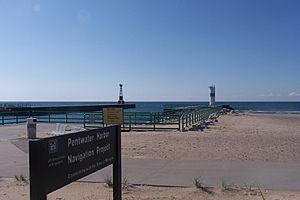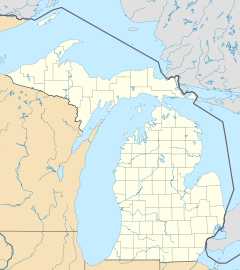Navigation Structures at Pentwater Harbor facts for kids
 |
|
| Pentwater pier, showing south (left) and north (right) pierhead lights | |
|
|
|
| Location | West End of Lowell St., Pentwater, Michigan |
|---|---|
| Coordinates | 43°46′56″N 86°26′38″W / 43.78216°N 86.44389°W |
| Year first constructed | south: 1937 / north: 1997 |
| Year first lit | 1873 |
| Automated | 1917 |
| Foundation | concrete pier |
| Construction | steel skeleton tower (south) / cylindrical "D9-type" tower (north) |
| Focal height | south: 48 feet (15 m) / north: 43 feet (13 m) |
| Original lens | red 6th-order Fresnel lens |
| Current lens | both: 12 inches (300 mm) optic |
| Characteristic | 0.5sec flash, 4.5sec eclipse |
| Fog signal | 3sec every 30sec |
| ARLHS number | south: USA1270 / north: USA594 |
| USCG number | 7-18620 and 7-18630 |
The Navigation Structures at Pentwater Harbor are important lights and piers located in Pentwater, Michigan. They help guide boats safely into and out of Pentwater Lake, connecting it to Lake Michigan. These structures are so important that they were added to the National Register of Historic Places in 2001. This means they are recognized as special historical places in the United States.
Contents
History of the Pentwater Lights
Early Beginnings (1855-1865)
Imagine a time when Michigan was full of forests! In 1855, a man named Charles Mears needed a way to move logs from Pentwater Lake to Lake Michigan. So, he built a channel, like a narrow river, about 70 feet wide. He lined it with strong timber (wood) to keep the sides from collapsing.
A few years later, in 1858, Mears built a long pier (a dock-like structure) that stretched over 600 feet into Lake Michigan. This was where ships could load and unload timber. He kept working on the channel, making it deeper. By 1865, it was deep enough for a large lake steamer, called the Daylite, to sail right into Pentwater Lake!
Government Improvements and First Lighthouse (1868-1917)
The channel was very useful, so in 1868, the United States government decided to make it even better. They made the channel wider, about 150 feet across, and deeper, about 16 feet deep. Two new piers were built.
In 1873, the first lighthouse was built on the south pier. It was made of timber and stood 33 feet tall. Inside, it had a special red 6th-order Fresnel lens. This type of lens was very advanced for its time, making the light much brighter and easier to see.
Later, in 1887, a life-saving station was built on the north pier. This station helped rescue people from shipwrecks or other dangers on the lake. In 1917, the lighthouse on the pier was updated to work automatically, meaning no one had to be there all the time to keep the light shining.
Modern Structures (1937-1997)
In 1937, the entire pier structure was replaced by the Army Corps of Engineers. They built strong new concrete piers. At the same time, the old timber lighthouse was replaced with a new one made of steel. The old lens was also replaced with a more modern 300-millimeter lens.
Most of the old life-saving station was taken down in 1958, except for its flag tower. Then, much later, in 1997, a second light was added on the north pier. This means Pentwater Harbor now has two important lights guiding boats.
What the Lights Look Like Today
The Pentwater navigational structures today include two concrete piers that reach out into Lake Michigan.
- North Pier Light: At the end of the north pier, you'll see a round, cylindrical tower. It has a green flashing light that comes from a 300-millimeter acrylic optic. This light is 43 feet above the water.
- South Pier Light: At the end of the south pier, there's a steel tower that looks like a skeleton. It has a flashing light from a 300-millimeter acrylic optic. This light is 48 feet above the water.
Both of these lights work together to help boats find their way safely into Pentwater Harbor, especially at night or in bad weather.


